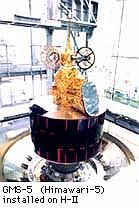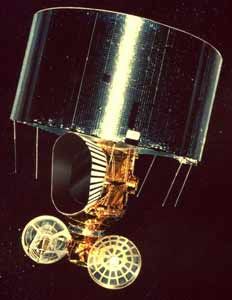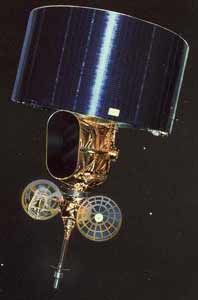
Home - Search - Browse - Alphabetic Index: 0- 1- 2- 3- 4- 5- 6- 7- 8- 9
A- B- C- D- E- F- G- H- I- J- K- L- M- N- O- P- Q- R- S- T- U- V- W- X- Y- Z
Himawari
 GMS Credit: NASA |
AKA: Geostationary Meteorological Satellite;GMS. Status: Operational 1977. First Launch: 1977-07-14. Last Launch: 1995-03-18. Number: 5 . Gross mass: 746 kg (1,644 lb).
They were developed to contribute to the improvement of Japan's meteorological services and the development of weather satellite technology.
The satellites consisted of a despun section which held the earth-oriented antennas and a 100-rpm rotating spin section which contained the Visible and Infrared Spin Scan Radiometer (VISSR), electronic devices, etc. They were used for the World Meteorological Organization's World Weather Watch Program which was sustained by five geostationary satellites. Launching organization: National Space Development Agency of Japan (NASDA). Function: 1) Observation of meteorological phenomena by the visible and infra-red spin scan radiometer. 2) Collection of weather data from various stations. 3) Distribution of weather data to earth stations. 4) Monitoring of solar particles.
NASA NSSDC Master Catalog Description
GMS 5 was a Japanese geostationary meteorological spacecraft. It replaced GMS 4 (1989-070A) and was initially parked at 140 E longitude. It carried visible and infrared spin-scan radiometers that provided global pictures every 25 minutes at a resolution of 1.25 km (visible) and 5.0 km (infrared). It also had an infrared channel to monitor water vapor content in the atmosphere. Other instruments on board were for search-and-rescue relays and for relaying weather data from ground/sea-based monitoring platforms. The spacecraft had a stabilized earth pointing platform and a 100 rpm spinning section. The spacecraft had a diameter of 215 cm and a height of 354 cm.
Family: Earth, Earth weathersat, Geosynchronous orbit. Country: Japan. Launch Vehicles: Delta, Delta 2914, N-2, H-1, H-II, Delta 2000. Launch Sites: Cape Canaveral, Cape Canaveral LC17B, Tanegashima, Tanegashima N, Tanegashima Y. Stages: Star 27. Bibliography: 2, 6.
 | Himawari Credit: NASDA |
 | Himawari 1 Credit: Manufacturer Image |
 | Himawari 2 Credit: Manufacturer Image |
1977 July 14 - . 10:39 GMT - . Launch Site: Cape Canaveral. Launch Complex: Cape Canaveral LC17B. LV Family: Thor. Launch Vehicle: Delta 2914.
- Himawari 1 - .
Payload: GMS 1. Mass: 670 kg (1,470 lb). Nation: Japan.
Agency: NASDA.
Class: Earth.
Type: Weather satellite. Spacecraft: Himawari.
Completed Operations Date: 1989-09-17 . USAF Sat Cat: 10143 . COSPAR: 1977-065A. Apogee: 36,148 km (22,461 mi). Perigee: 36,005 km (22,372 mi). Inclination: 11.10 deg. Period: 1,451.00 min.
Geostationary meteorological satellite. Positioned in geosynchronous orbit over the Pacific Ocean at 140 deg E in 1977-1981; over the Pacific Ocean 160 deg E in 1981-1984; over the Pacific Ocean 140 deg E in 1984; over the Pacific Ocean160 deg E in 1984-1989 As of 29 August 2001 located at 10.47 deg W drifting at 3.675 deg W per day. As of 2007 Mar 10 located at 112.63E drifting at 3.690W degrees per day.
1981 August 10 - . 20:03 GMT - . Launch Site: Tanegashima. Launch Complex: Tanegashima N. LV Family: Thor. Launch Vehicle: N-2.
- Himawari 2 - .
Payload: GMS 2. Mass: 670 kg (1,470 lb). Nation: Japan.
Agency: NASDA.
Class: Earth.
Type: Weather satellite. Spacecraft: Himawari.
Completed Operations Date: 1988-02-01 . USAF Sat Cat: 12677 . COSPAR: 1981-076A. Apogee: 36,034 km (22,390 mi). Perigee: 35,943 km (22,333 mi). Inclination: 12.90 deg. Period: 1,446.40 min.
Geostationary meteorological satellite. N launch vehicle flight number 8 (N-II launch vehicle). Launch time 2003 UT. Launching organization: National Space Development Agency of Japan (NASDA). Geostationary longitude 140 deg E. Function: 1) Observation of meteorological phenomena by the visible and infra-red spin scan radiometer. 2) Collection of weather data from various stations. 3) Distribution of weather data to earth stations. 4) Monitoring of solar particles. Positioned in geosynchronous orbit at 160 deg E in 1981; 140 deg E in 1981-1984; 145 deg E in 1984-1985; 120 deg E in 1985-1988 As of 31 August 2001 located at 33.93 deg E drifting at 2.598 deg W per day. As of 2007 Mar 9 located at 153.66W drifting at 2.594W degrees per day.
1984 August 2 - . 20:30 GMT - . Launch Site: Tanegashima. Launch Complex: Tanegashima N. LV Family: Thor. Launch Vehicle: N-2.
- Himawari 3 - .
Payload: GMS 3. Mass: 303 kg (668 lb). Nation: Japan.
Agency: NASDA.
Class: Earth.
Type: Weather satellite. Spacecraft: Himawari.
Completed Operations Date: 1995-06-22 . USAF Sat Cat: 15152 . COSPAR: 1984-080A. Apogee: 35,942 km (22,333 mi). Perigee: 35,877 km (22,292 mi). Inclination: 9.80 deg. Period: 1,442.40 min.
Stationed at 140 deg E; also studied alpha particles, electrons. GMS-3 (Himawari-3). Launch 2030 GMT. Improvement of meteorological observation. Development of meteorological satellite technology. N Launch vehicle flight no 13. Launching organization NASDA. Positioned in geosynchronous orbit at 140 deg E in 1984-1989; 120 deg E in 1989-1995 As of 28 August 2001 located at 146.92 deg E drifting at 1.558 deg W per day. As of 2007 Mar 11 located at 168.90W drifting at 1.566W degrees per day.
1989 September 5 - . 19:11 GMT - . Launch Site: Tanegashima. Launch Complex: Tanegashima N. LV Family: Thor. Launch Vehicle: H-1.
- Himawari 4 - .
Payload: GMS 4. Mass: 725 kg (1,598 lb). Nation: Japan.
Agency: NASDA.
Class: Earth.
Type: Weather satellite. Spacecraft: Himawari.
Completed Operations Date: 2000-02-24 . USAF Sat Cat: 20217 . COSPAR: 1989-070A. Apogee: 36,807 km (22,870 mi). Perigee: 36,410 km (22,620 mi). Inclination: 6.20 deg. Period: 1,478.30 min.
Stationed at 140 deg E. GMS-4 (Himawari-4). Improvement of meteorological observation. Development of meteorological satellite technology. Launch vehicle H-I (H20F). Launching organization NASDA. Launch time 1911 GMT. Positioned in geosynchronous orbit at 160 deg E in 1989; 140 deg E in 1989-1995; 120 deg E in 1995-1999 As of 4 September 2001 located at 126.83 deg E drifting at 10.301 deg W per day. As of 2007 Mar 9 located at 71.28W drifting at 10.305W degrees per day.
1995 March 18 - . 08:01 GMT - . Launch Site: Tanegashima. Launch Complex: Tanegashima Y. LV Family: H-2. Launch Vehicle: H-II.
- Himawari 5 - .
Payload: GMS 5. Mass: 746 kg (1,644 lb). Nation: Japan.
Agency: NASDA.
Class: Earth.
Type: Weather satellite. Spacecraft: Himawari.
USAF Sat Cat: 23522 . COSPAR: 1995-011B. Apogee: 35,791 km (22,239 mi). Perigee: 35,784 km (22,235 mi). Inclination: 0.60 deg. Period: 1,436.00 min.
Geostationary Meteorological Satellite; carried search and rescue package. Stationed at 140.2 deg E. Positioned in geosynchronous orbit at 160 deg E in 1995; 140 deg E in 1995-1999 As of 5 September 2001 located at 139.99 deg E drifting at 0.028 deg W per day. As of 2007 Mar 10 located at 45.88E drifting at 3.134W degrees per day.
Back to top of page
Home - Search - Browse - Alphabetic Index: 0- 1- 2- 3- 4- 5- 6- 7- 8- 9
A- B- C- D- E- F- G- H- I- J- K- L- M- N- O- P- Q- R- S- T- U- V- W- X- Y- Z
© 1997-2019 Mark Wade - Contact
© / Conditions for Use